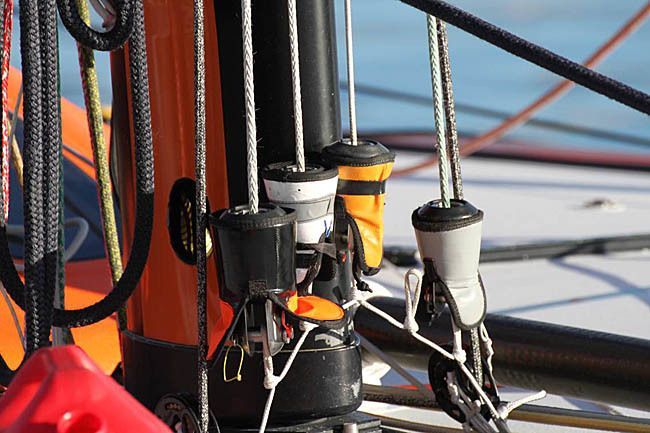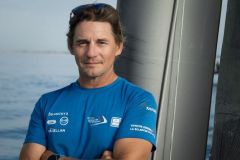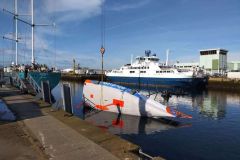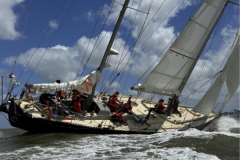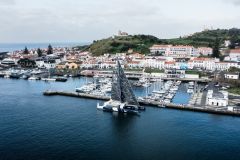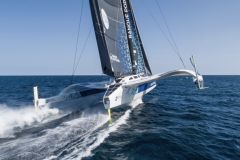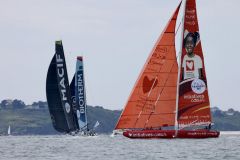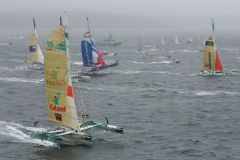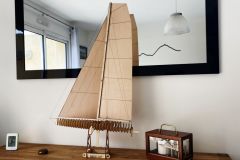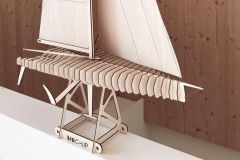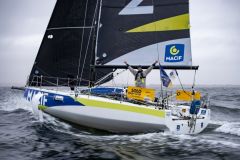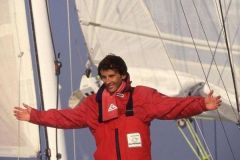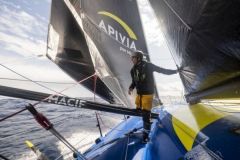A hook, what's that?
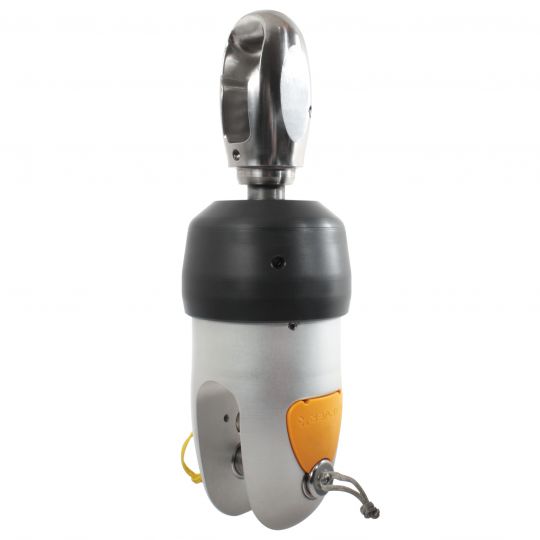
The hook is by definition a hook. In boating it is a system that allows the sail to be locked at the head or at a defined point and to take up the tension from below. There will then be no more tension in the halyard. The advantages are multiple but mainly the reduction of compression in the mast, a considerable weight saving and finally performance via the speed of the manoeuvre.
The hooks we are interested in here are those of the Code 0 type headsails, staysail, staysail, capelage..
Karver was the first sailmaker to develop this system, which integrates a swivel and therefore allows a headsail to be rolled and unfurled. It consists of a fixed part on the mast and a swivel with teeth and its locking system.
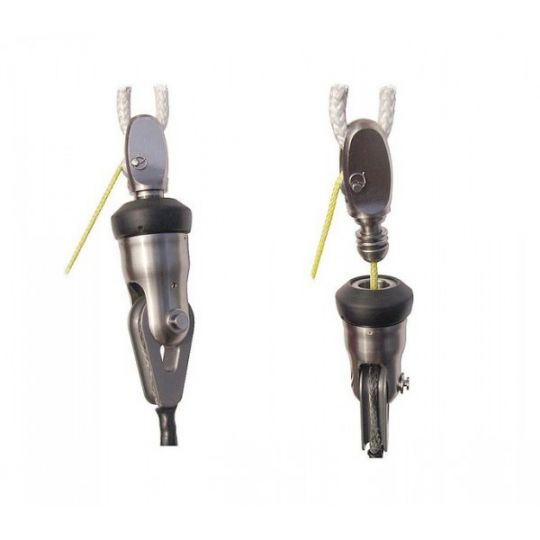
" The furled sail is hoisted with a conventional single halyard. At the top, the halyard tension will put the system in compression and therefore lock. We can release the tension and have a halyard with no load. The luff tension will be taken up by the tack hoist underneath the sail wrap. Then we can unfurl and sail. The unhooking is done (after furling the sail) by releasing the tack tension and retaking the halyard tension to put the system back in compression. An ingenious rotary lock allows the tines to be played on a height allowing them to move away from the fixed part. This is the principle of the Bic pen ", explains Aloïs.
Equipment installed on a large majority of IMOCA aircraft
This system was designed in 2005 and equipped many of the boats in the 2008 Vendée Globe, including those of Jean Le Cam, Vincent Riou, Armel Le Cléac'h, Marc Guillemot and many others. The product was well born and has undergone few changes since it was introduced.
Today, nearly 70% of the fleet at the start of the 2020 Vendée Globe is equipped with Karver hooks, which corresponds to around 80 hooks on the water at the moment, proving the validity of the product.
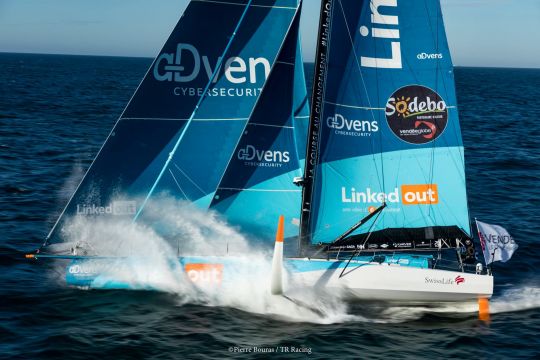
Today, it is impossible to do without hooks on the current IMOCAs. Without this system, the effort on the mast and its peripherals would be too great. The manoeuvres would be longer and more tiring for the skippers.
Return to port and solidarity of seafarers

According to the organization's press release, Fabrice Amedeo has returned to port following a hook block. What really happened?
" The team finally informed us that a halyard had got caught in the sail during furling. Under high tension, this halyard ripped the mast 6 cm below the halyard exit light, making the halyard 3 cm long and hindering the proper functioning of the hook. The Karver KFH hook is therefore not the cause of the problem. It is a collateral damage. In any case, the efforts were significant. Although there was no apparent problem, the team preferred to restart the race with a verified hook ", confirms Aloïs.
A carbon patch was glued to the torn area, and the whole system was changed. It should be noted that the solidarity of the seafarers is very much present in the world of competition, as it was the Banque Populaire team who made their equipment available to carry out this repair. Fabrice, happy and relieved to know the origin of his problem, set out again at sea during the night of Tuesday 10th November, in pursuit of the other competitors.

Arnaud Boissière (Cali) also had to deal with a problem of not unhooking, which he was able to resolve after climbing the mast. It is difficult to make a precise analysis of the problem encountered by Cali, but it would appear that the halyard in question was changed just before the start. The racers are asked to "hover" the halyards before setting off, as a new halyard always loses a little bit of material in the sheaves, and it is possible that this clogs up the hook locking system, thus jeopardising its proper operation.
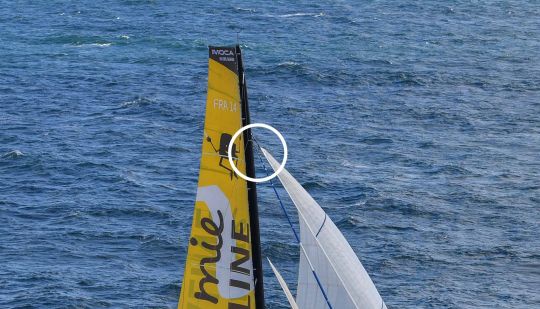
Thomas Ruyant also encountered minor hooking problems, probably due to intensive pumping of the mast.
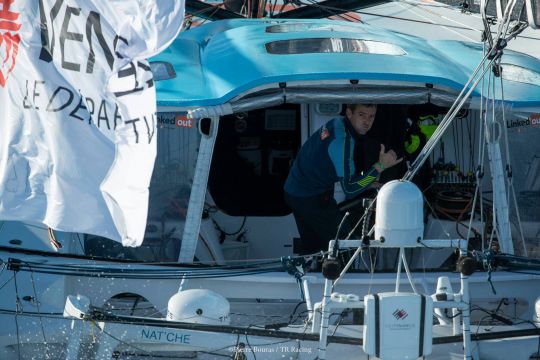
Armel Tripon, meanwhile, broke his J3 hook from another manufacturer than Karver (windsail) and managed to install a replacement system.
How can we avoid these problems?
With a 29m high spar, it is difficult for a skipper to see with the naked eye if everything is in order at the top of his mast. Karver has developed a sensor which, via a sound or light signal, signals that the hook is correctly hooked. Some teams have also installed a small camera in the mast, which allows them to check the progress of the manoeuvre in real time. However, this equipment is not widely used, as it adds weight at high altitudes, reducing the overall performance of the boat.
Several skippers have also undergone technical training in Karver's workshops, in order to perfectly master this essential equipment.
" With our experience we know that the hooking systems are very reliable, but require a great deal of rigor in their installation and use. The easy disassembly allows easy replacement of the main parts, which are usually in the "spare" box on the edge. Today these machines are going faster and faster and the efforts increase with the power of the boats. Eventually we will be able to instrument everything. The most complicated thing to manage is the manoeuvre when the skipper is exhausted, here mistakes can happen quickly and be fraught with consequences ", concludes Aloïs.
